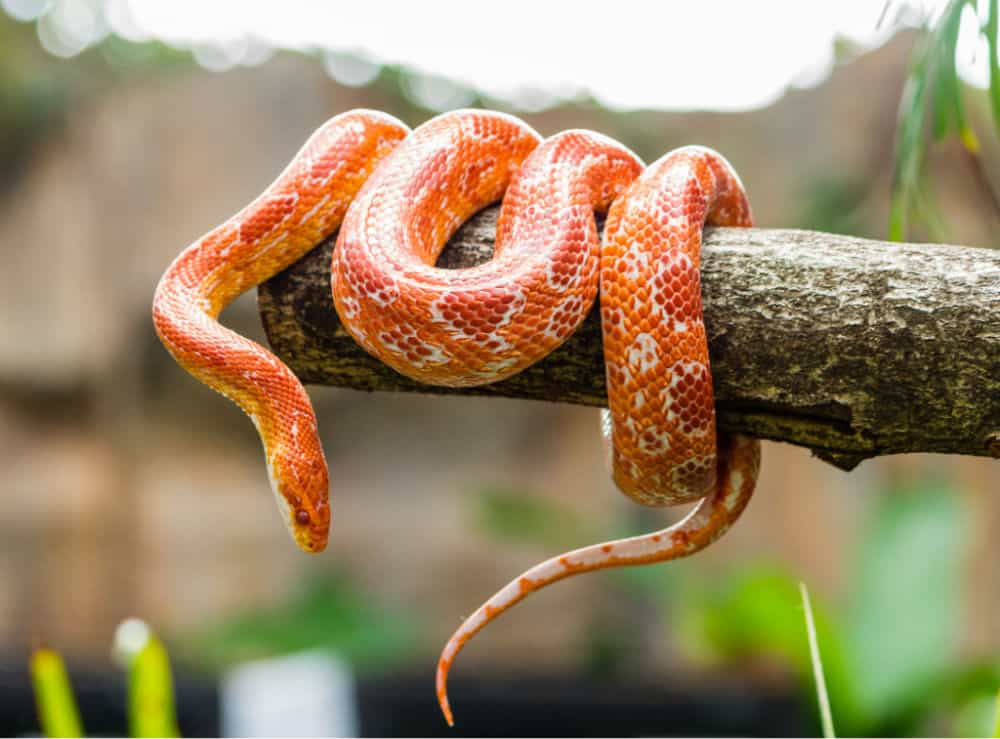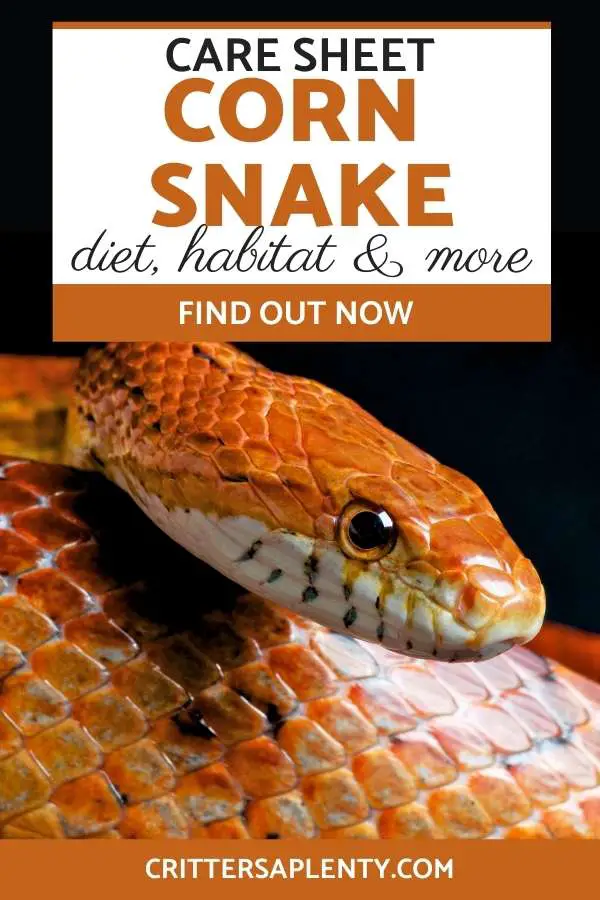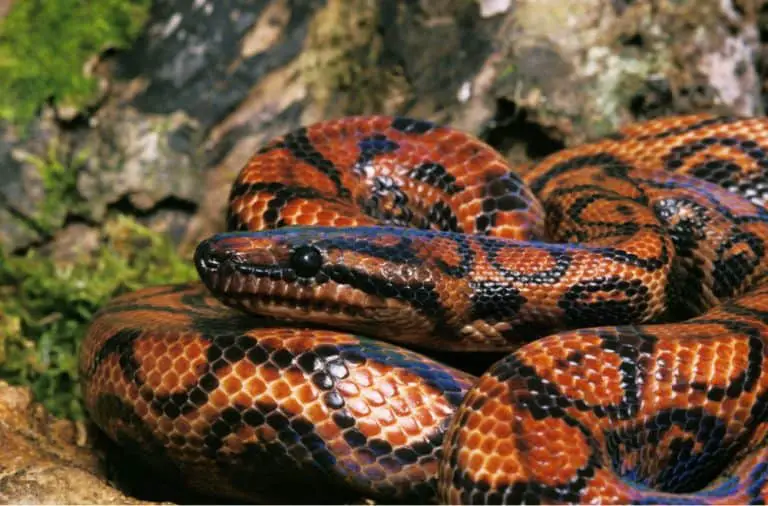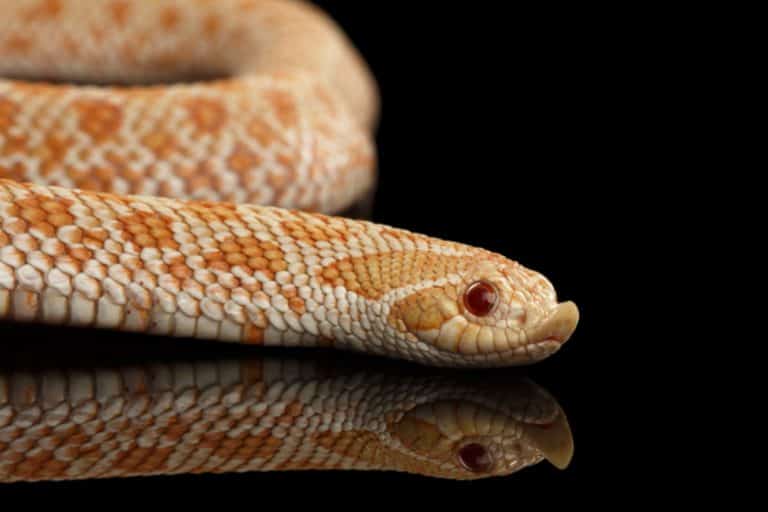Corn Snake Care Sheet: Diet, Habitat, & More
Corn snakes are a beloved pet across America. Their calm and docile demeanor makes them a great introduction to the snake keeping world. And since adult corn snakes are only 2-5 feet, they don’t take up much room at all. With their vibrant colors and unique markings, you might be wondering how to take care of corn snakes yourself—caring for corn snakes are not as hard as it seems. Let’s go on this journey together to cover everything you need to know about corn snakes.
Corn Snake Overview
Before we start talking about caring for corn snakes, let’s talk about what they are. Corn snakes are native to the Eastern US. It got its name because they were regularly seen around corn fields and grain stores, eating the small mice and rats that fed on the corn. Wild corn snakes come in orange, brown, and grey colors. But domesticated corn snakes come in beautiful morphs with different colorings and markings. Currently, 14 stunning morphs make it hard to choose just one.
Once you choose your beloved snake, you can expect to have 10-15 years with them. And with exceptional care, don’t be surprised if your corn snake lives past 20. Our goal is to give you the best advice for the longest life expectancy. But to get to 20 years, you will need to imitate their natural habitat as closely as possible. Giving them the perfect terrarium and lots of places to hide will make your corn snake right at home.
Terrarium Setup
Corn snakes get 2-5 feet long, but despite what you might think, they don’t need a large setup. A traditional 20-gallon glass terrarium is perfect for an adolescent snake and can upgrade to a 40-gallon when they are adults. Your corn snake will spend most of their time curled up in a hide or buried in the substrate. In fact, a large terrarium might frighten and overwhelm your corn snake. So bigger is not better in this case.
Your terrarium should also have a screened lid for humidity control and airflow. But, be careful of these lids. Corn snakes are excellent escape artists and can get out quickly. They love to creep along the tops of the terrarium to find weak points for a quick escape. You will want several cage clips all around the top of the cage. And as they get older and stronger, you will need to add extra protection. Some owners add weights to the top, but even then, some will escape.
Inside the terrarium, you will want to have some decorations. A hide big enough for them to curl up in is the most important. You will also want to add a branch or two and some foliage. They love to explore their surroundings and climb up branches. You can even be creative and create the perfect oasis for your snake. And for enrichment, you can change a few decorations every few months. Just don’t go overboard and create a new tank every month, or you risk stressing your snake out. Keep the hide, water dish, and hot spots constant and change up the rest.
Heating, Lighting, And Humidity
Corn snakes are a cold-blooded reptile, which means that they regulate their body temperature by basking. You will need to have cool and basking areas in the tank. On the basking side, you will need a temperature of 80-85 degrees. But you don’t provide basking areas like with other reptiles for a corn snake. They prefer to have their bellies warmed to help with digestion. Using an under tank heater with a thermostat is the best option.
The cool side of the tank needs to be 70-80 degrees. Most homes are the perfect temperature of 71-72, which is ideal for your snake. But if you keep your home on the cooler side, you might want to think about getting a ceramic heat emitter. Ceramic heat emitters don’t provide any light, but they will keep your tanks warm enough. Each ceramic heat emitter brand will have different recommendations for what wattage to use. Follow the guides they provide to help adjust the ambient tank temperature.
And the only light you might have on your snake is a UVB light. There is some debate as to if a UVB is necessary for corn snakes. Since corn snakes like to come out at night mostly, they don’t usually bask in the sun. But some studies have shown that UVB can aide in snake digestion and improve their moods. Most snake keepers keep a low wattage UVB bulb on for these reasons and to help regulate their day/night cycles. As long as it’s a low wattage bulb, it won’t hurt them.
The key to lighting is to choose low wattages. Since corn snakes are more likely to come out when it is dark, bright lights will make them hide more. That is why the under tank heater and ceramic heat emitters are more popular. But if you have to use a low wattage UVB, it won’t bother them as much and will give you a viewing light. The only lights you want to stay away from are red-colored lights. Red will hurt their eyes and disrupt their sleeping patterns.
In addition to providing the proper heat, you also need to provide humidity. Remember, corn snakes live mostly along the East Coast. Their ideal humidity is between 40-50%, which is essential to condition the skin and help aid in shedding. Placing a hygrometer inside the tank will help you gauge this. In dryer climates, you might have to spray the tank down every once in a while. Checking the humidity levels every morning and every night will keep your snakes hydrated and healthy.
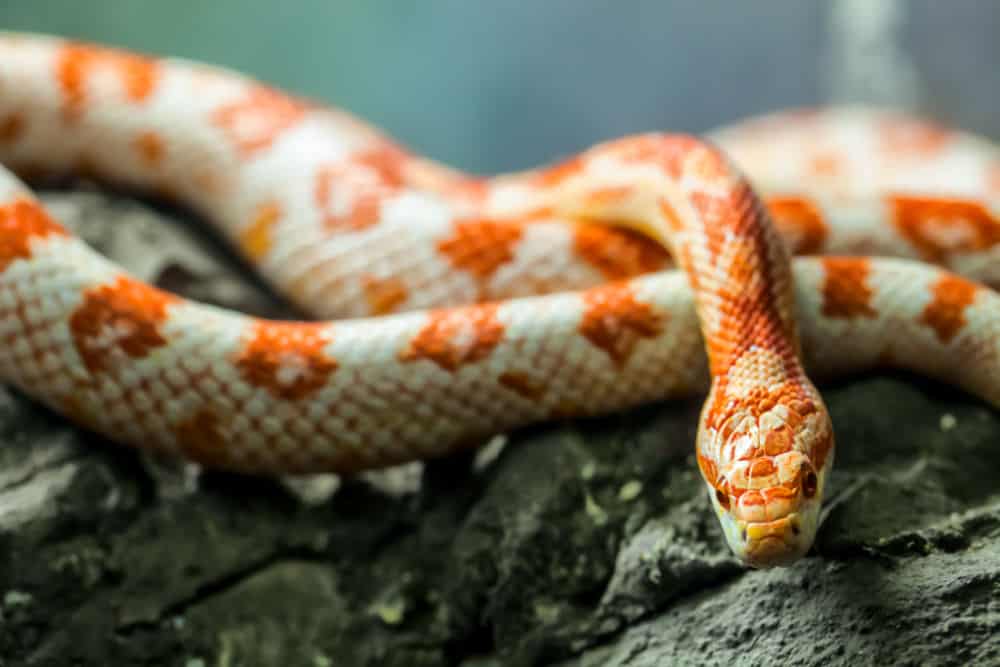
Substrate
Most new corn snake owners love to use aspen as their substrate. Aspen is cheap, smells nice, and allows your snake to burrow naturally. But many owners have a hard time keeping the humidity up with aspen. So, in a search for the perfect substrate, most concoct a mixture of their own. Some people love using half aspen and half coconut fiber. Some use a combination of Reptisoil and play sand. But which is better?
This depends on where you live. As mentioned before, maintaining 40-50% humidity is your goal. So in dry climates, you might want to opt for a substrate that holds moisture, like coconut fiber. In areas where the humidity is higher than average, aspen will work better. And with the change of seasons, you might notice that your substrate will need to be changed as well. Playing around for the perfect combination will give you the best results.
Some snake owners use a simple paper towel at first. But paper towels are not sustainable in the long run. Your snake can’t burrow in paper towels, and they soil easily. Some snakes might become stressed in enclosures with paper towels instead of bedding. So we only recommend to use it in extreme cases. If your snake is sick with parasites, paper towels are cleaner until your snake is better, for instance.
For the experienced reptile owner, they choose to have a BioActive substrate. BioActive substrates are specifically designed to house smaller microfauna that help clean the tank clean. A BioActive tank can be complicated to start and maintain. But once you have the perfect ecosystem set up, you will have to do minimal cleaning and maintenance.
Feeding
One of the most confusing aspects of caring for corn snakes is feeding. Your corn snake will feed on small mice. Most snake owners prefer to feed their snakes a frozen mouse diet called artic mice. These mice are bred in large quantities and euthanized humanly. Then they are flash-frozen to provide your snake with the most nutrition possible. The reason owners prefer frozen mice is because it poses little risk to your snake.
Feeding live is always an option, but there are certain risks you take. The most significant risk is that mice will fight to survive. In their fight, they will harm your snake to get away. There are countless stories of mice that have injured snakes badly in their struggles. But frozen mice still have some level of concern. You have to have proper handling of the mice to prevent bacteria from growing that will get your snake sick.
To feed frozen mice, you need first to thaw them in the fridge overnight. Then place them and their bags into a cup of hot water. You want to heat them until they are about 100 degrees to emulate a live feeder. Most corn snakes will pounce at anything you place in the cage. But you should give them a little enrichment by dangling the mouse in front of them with a pair of long feeder tongs.
In some cases, a snake will not eat a frozen mouse. No matter what tricks you try, they just won’t take it. And that’s ok. Feeding your snake live mice might seem scary, but it is natural. To take a little precaution, only allow the mouse to be in the cage for an hour before removing it. The longer a mouse is in there, the greater the chance that it will bite your snake.
You might be wondering what sizes to feed your snake and how often. And this is an essential question to ask. You don’t want your snake to eat too often, but you don’t want them to go too long between feedings. Feeder mice, even frozen, come in several sizes for all ages of snakes: pinkies, fuzzies, small mice, and adult mice. When choosing a feeder size, pick a size that is no more than 1.5 times the width of their body.
Most corn snakes that you buy at the pet store are about 2-4 months old, and they typically eat anywhere from one to two pinkies every week. Once your snake is about six months old, they will be on the verge of needing a size upgrade. If your snake is eating more than four pinkies every week, it is time for an upgrade. From 6-12 months old, they should be switching to fuzzies. At this age, they will eat 1-3 fuzzies every 7-14 days. And at around 16 months, they will change to small mice and eventually adult mice. They will typically eat less at this time and might go as long as 21 days without eating.
And unlike other reptiles, you don’t have to worry about supplements. Your snake won’t need the calcium or other vitamins. They get everything they need from eating the whole mice. If they aren’t eating, that is a whole different story, and you might want to talk to your vet before self-treating.
Another common myth is that you have to feed your snake in a separate container. The thought was that providing a snake in a separate box will keep them from mistaking your hands as food. But this myth has long been busted for several reasons. For one, a snake has an impeccable sense of smell. And as long as you haven’t just handled their food, snakes know it’s you. And secondly, moving your snake for feeding could stress them out. They feel helpless and exposed and are less likely to eat. So keep your snakes in their enclosure for feedings and always wash your hands before handling them.
Water
Snakes are the cutest when they are drinking water. If you ever catch a glimpse of your snake sucking up water, it will be the most adorable thing ever. In the terrarium, you will want a large enough dish that they can soak themselves easily. If your water dish is large enough, you will be surprised to know that corn snakes also swim. Another benefit is that a large water dish will also help keep the humidity in the tank at the perfect percent.
But what type of water do I use? Regular tap water should be adequate for your snake. Some people worry about having chlorine in the water, but it poses no risks to your corn snake. In fact, some studies show de-chlorinator might hurt your corn snake. If you are worried about chlorine, then setting a jug of water out for 24 hours will allow it all to evaporate.
You don’t want to use distilled water for drinking water because it doesn’t have minerals. Without these minerals, your snake will become ill and develop bone structural problems. Tap water will have all the minerals to keep your snake hydrated. But distilled water is great for misting because it won’t leave hard water stains on your tank.
Common Health Issues
Corn snakes are not considered a delicate reptile. But all reptiles are prone to health issues if they aren’t correctly cared for. One of the most common health issues is the stuck shed. Stuck shed happens when there is not enough humidity in the tank during shedding times. Humidity is crucial to the shedding process, and a stuck shed will cause damage to the scales and eyes. If your snake has stuck shed, try giving a soak to increase the moisture of the skin. You could also try providing a humid hide with wet peat moss.
Another common ailment is mites. Your snake can get mites from dirty bedding or bedding that has been contaminated. Getting rid of mites is a challenging process. You will want to do daily soaks of your snake to suffocate the mites and kill the eggs. Then you will want to clean the cage daily with a mite insecticide that is safe for snakes. Most owners remove all bedding during this time and use paper towels until all clear.
Constipation is another common problem with snakes of all kinds. Usually, constipation happens from a combination of different things. Not enough heat is the leading cause of constipation. Double-check that your under tank mat is working and is warm enough to help digest food. If that seems to be good, make sure that the humidity is high enough and that your snake has clean drinking water. Sometimes a warm bath will also help your snake go to the bathroom. If nothing seems to work, don’t feed your snake again until they go. And you might want to make an appointment with the vet to rule out other issues.
Internal parasites are another sneaky culprit to look out for. Most young corn snakes will have parasites at some point in their life. It is unpleasant and will decline the health of your snake rapidly. Weightloss and no appetite are usually the first signs that something is wrong. If you suspect internal parasites, you should talk to your vet immediately for treatment plans.
And finally, respiratory illnesses can be expected if your humidity is too high. Since snakes live in a warm glass-covered terrarium, it can be a breeding ground for bacteria. But you shouldn’t have an issue with this is the humidity is kept at the recommended 40-50%.
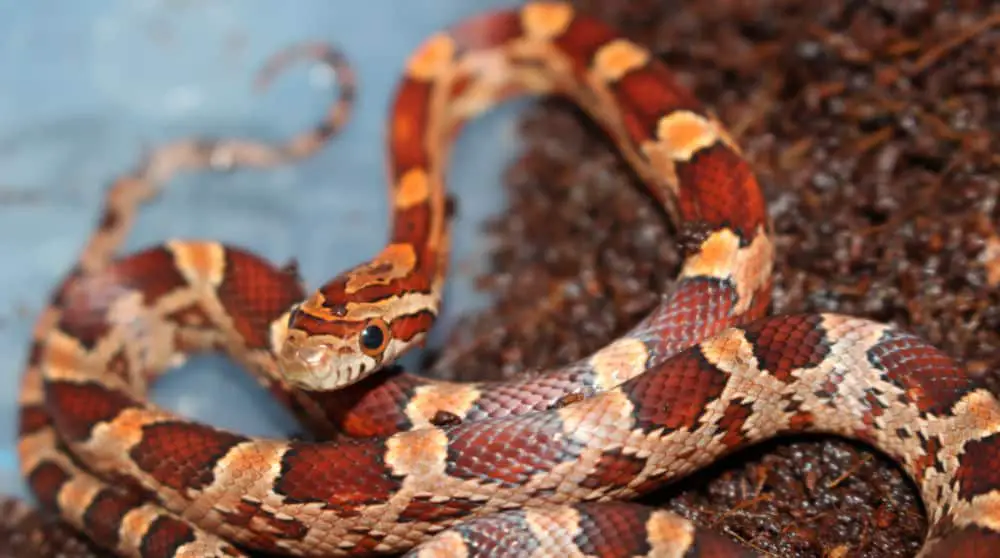
What Does A Healthy Snake Look Like?
Doing a daily health check will keep your snake in tip-top shape. During the daily inspections, you should look for dirty bedding, poo in the cage, and make sure all humidity and temperatures are on point. You will also need to check the overall health of your snake. Doing this daily will make sure that you catch any abnormalities before they take over.
Appetite: The first thing that seems to go when your snake is sick is their appetite. While you can’t track this every day, you can keep a chart of their eating habits. You will also want to track weight, and any poops your snake has had. Knowing these things might seem like an easy thing to follow, but knowing the exact dates of changes helps you figure out any inconsistencies.
Skin Condition: You should check daily that your snake is hydrated and vibrant in color. The skin should look taught and shiny, not dull and wrinkled. Now, if your snake is about to shed, they will look a little dull with cloudy eyes, which is normal. Simply increase the humidity a little to make sure that the shed goes quickly and effortlessly.
Hiding: Hiding during the daytime is entirely normal. And juveniles will hide more than adults. As long as your snake is eating, drinking, and exploring at night, your snake is behaving normally. If your snake is out more often than usual, it is typically a sign that they are hungry.
Weight: And finally check that your snake is not losing any weight. If a snake has parasites, you will notice rapid weight loss. You should also check that your snake has not gained too much weight, though this is less noticeable as weightloss.
If you suspect that your snake is sick in any way, contact your vet immediately. Snakes will try to hide any illness for as long as they can. So if they start acting sick, it could be worse than you might initially think. Fast treatments will get your corn snake feeling his best again.
Temperament And Handling
Next, in this corn snake care sheet is about temperament and handling. Corn snakes are docile and only react when they feel threatened. Juveniles tend to be a little feistier out of self-preservation. But once your snake gets used to you, they are easy to handle. This connection might take a while to form, but it can be gratifying in the end. Keep your patience, and don’t be afraid as your corn snake will sense this.
To gain your snake’s trust, start with small handling periods, and increase them over time. Gently but firmly grab him by the body and place him in your hands. Naturally, they will try to get away, so you will need to move your hands to their movements. No matter what, don’t let your snake get away from you. Once they calm down, you can set them back into the cage. The trick to this method is to not do this for long. Start with about five minutes and increase slowly over time.
In a few months, you will find that your snake is completely happy coming out of the terrarium. The only thing to watch out for is not to handle for a few days after feeding. Disturbing a snake that is digesting could cause it to regurgitate its food. Soon you will find that the most thrilling part of caring for corn snakes is letting them explore your world.
Cleaning
Keeping your corn snake’s terrarium clean is easier than some animals. Since snakes don’t eat every day, they don’t tend to be messy creatures. Spot cleaning your tank after feeding will lead to going longer times between deep cleans. Look for feces, molded substrate, and bits of leftover food to clean daily. Scooping these out and replacing them with fresh bedding will last you at least a month.
For deep cleaning, you will need a few supplies:
- carrier
- vinegar
- drying towels
For cleaning, you should be as quick as possible not to stress your snake. Most people put their snakes in a smaller carrier until they finish. Once you have removed your snake, take out the decorations, and have them soak in hot water and soap. Dump all of the bedding and spray down the tank with diluted 1:1 vinegar. Wipe the tank clean and let it dry while cleaning the decorations. Once the decorations have been cleaned and rinsed well, you can start putting your tank back together.
Since cleaning days are a stressful time for snakes, try to keep their set up the same. You can add a few new decorations, but don’t make a significant change. You might also want to give them a few days to readjust to their surroundings before handling again.
Do Corn Snakes Make Good Pets?
A corn snake is a fantastic pet to have. They aren’t super complicated, and they make great pets for beginners. If you have a responsible older child, they can also be a way to have a cool pet and learn responsibilities. But ultimately, the snake will be under your watch.
A corn snake’s snoot will win the hearts of even the biggest ophidiophobia. Anyone with a fear of snakes will soon grow to love yours. And you will find an odd sense of respect and adoration to your corn snake. If you can read this corn snake care sheet with excitement, then you will make the perfect snake pet parent.
When reading this corn snake care sheet, it might seem overwhelming at times. But once you have the basics down, corn snakes are one of the easiest reptiles to care for. They aren’t too complicated and thrive as long as they get what they need.
In Summary
Corn Snakes will captivate the hearts of everyone. And with our corn snake care sheet, we have given you everything you need to succeed. Your corn snake will feel safe and secure with you. And you will be happy knowing that you are giving the best life possible for him. Although snakes aren’t affectionate, you will be fulfilled knowing that they are comfortable and satisfied.

